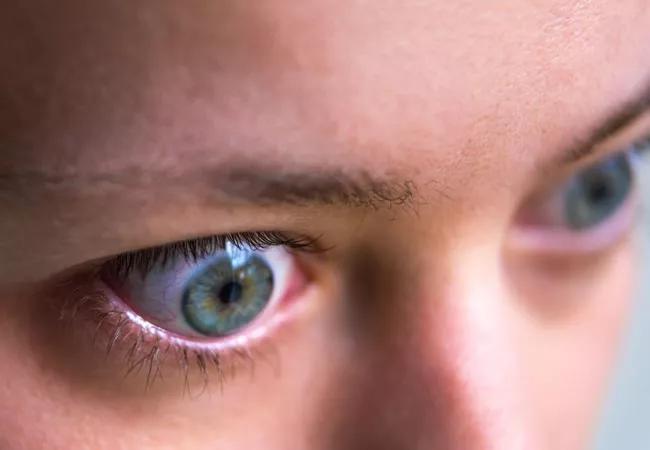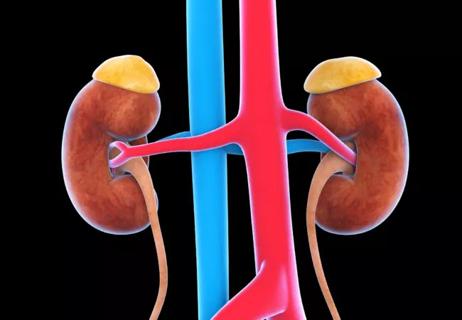Treating a rare eye disease with a multi-disciplinary approach

A 75-year old woman presented with a history of hypothyroidism diagnosed four years before coming to Cleveland Clinic’s Endocrinology & Metabolism Institute. Her primary care physician prescribed her levothyroxine, and her thyroid levels returned to the normal range. However, a month before she met with a staff physician in the Department of Endocrinology, she complained to her primary care physician about double vision. This necessitated neurological work-up, which included an MRI. The patient did not show evidence of stroke or neoplasm; however, MRI showed bilateral stranding of orbital fat suggesting the possibility of thyroid eye disease (TED). MRI of the orbits showed severe enlargement of multiple bilateral extraocular muscles with sparing of the myotendinous junctions and crowding of the orbital apex threatening the optic nerves.
Cleveland Clinic is a non-profit academic medical center. Advertising on our site helps support our mission. We do not endorse non-Cleveland Clinic products or services. Policy
When the patient saw the endocrinologist, she was thyrotoxic on 25 mcg of levothyroxine, and she had elevated TSH-receptor antibodies. She was diagnosed with Graves’ disease. The medication was discontinued, but her hyperthyroidism continued after a few weeks with elevation of T4 and T3. She was started on methimazole. Assessment of her TED activity revealed a clinical activity score (CAS) of 5/7 (CAS > 3 indicates active disease).
At that point, she was referred to Catherine Hwang, MD, an oculofacial plastic surgeon at Cleveland Clinic’s Cole Eye Institute. Due to the patient’s severe disease with inflammation and vision loss, Dr. Hwang recommended weekly IV methylprednisolone 0.5 g with the patient’s first dose administered immediately. Unfortunately, her vision did not improve, so she underwent bilateral medial-wall orbital decompression with improvement of vision. The patient continued to have active TED manifested by redness, swelling, pain and diplopia but, luckily, her vision improved. She was also started on an immunotherapy treatment called teprotumumab, targeted at the insulin-like growth factor receptor (IGF-R) and had decreased inflammation but continued to have double vision. In the future, this patient may need other treatments but for now, is doing well.
TED of variable severity occurs in 25% to 50% of patients with Graves’ disease. TED is more common in women, which is consistent with the epidemiology of Graves’ disease; however, it tends to be more severe in men. Most patients have hyperthyroidism or Graves’ disease but a small minority of patients, 5%, are euthyroid at presentation, and some patients can also be hypothyroid. In most cases, thyroid dysfunction and TED occur within 18 months of each other. TED usually affects both eyes, but one side can be more affected than the other. Some of the risk factors for the development and progression of TED include cigarette smoking and radioactive iodine therapy.
Management of thyroid eye disease is complex and customized to the individual patient. Unfortunately, TED is one of the most difficult diseases to predict. Most patients with TED have a mild course, but some can have severe disease with double vision, eyelid retraction, severe dry eye and vision loss. Some treatments used in the active phase, which can last 18 to 24 months, include supportive therapy with artificial tears and maintaining a euthyroid state. With more severe inflammation, intravenous steroids and/or possibly other immune therapies may be indicated.
If a patient has compressive optic neuropathy resulting in vision loss, sometimes surgery is needed. Luckily, most patients enter a stable phase of disease approximately 24 months after the onset of symptoms.
TED is often managed in a multidisciplinary fashion with collaboration between an endocrinologist and an ophthalmologist. Radioactive iodine is often used to treat Graves’ disease, but some authorities believe it is associated with new or worsened eye disease. The endocrinologist typically monitors thyroid hormone levels closely to make sure the patient does not develop hypothyroidism which may potentially worsen ocular symptoms. Typically, the comprehensive ophthalmologist monitors the patient’s symptoms and vision and when a patient requires surgery the patient may be referred to an oculofacial plastic surgeon.

Giving young patients a hand as they take charge of their own health

Case illustrates how easily condition can mimic preeclampsia

Guidance for counseling patients on the use of one of the most common daily supplements taken in the US

Understanding vitamin A toxicity and treatment

For patients with kidney disease, failure to recognize all parathyroid glands can result in failed surgery

Focus on metabolic bone disease

Case report illustrates the importance of maintaining high levels of clinical suspicion

PCPs rate their knowledge levels of the condition ‘average’ and desire further education